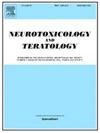Dl-3-n-butylphthalein inhibits neuronal apoptosis and ferroptosis after cerebral ischemia-reperfusion injury in rats by regulating CXCR4
IF 2.8
3区 医学
Q3 NEUROSCIENCES
引用次数: 0
Abstract
Objective
To investigate the anti-apoptosis and anti-ferroptosis effects of dl-3-n-butylphthalide (dl-NBP) on cerebral ischemia-reperfusion injury (CIRI) in rats, and the potential involvement of cysteine-X-cysteine chemokine receptor 4 (CXCR4).
Methods
The differentially expressed genes between healthy people and stroke patients were screened by GEO database. A transient middle cerebral artery occlusion rat model was used to induce CIRI in vivo. Rats were randomly divided into sham group, tMCAO group, and dl-NBP + tMCAO group. The therapeutic effect of dl-NBP in vivo and its effect on apoptosis and ferroptosis in brain tissues were evaluated. An in vitro oxygen-glucose deprivation/reperfusion (OGD/R) model was established to simulate CIRI in cultured PC12 cells, and the effects of dl-NBP on apoptosis and ferroptosis were examined. In this model, CXCR4 expression was assessed by western blotting and its involvement in dl-NBP-mediated protection assessed by inhibition with AMD3100.
Results
In the stroke-related GSE22255 and GSE66724 datasets, a total of six genes with increased co-expression were found, including CXCR4. Dl-NBP treatment significantly reduced both the volume of cerebral infarction and the degree of cerebral edema, and improved neurological function in rats. dl-NBP reduced the degree of apoptosis and ferroptosis and alleviated CIRI both in vivo and in vitro. The pro-survival effects of dl-NBP were significantly reversed after CXCR4 inhibition with AMD3100.
Conclusion
Dl-NBP has anti-apoptotic and anti-ferroptotic effects on CIRI both in vivo and in vitro, and this effect is mediated by CXCR4.
dl -3-正丁苯酞通过调节CXCR4抑制大鼠脑缺血再灌注损伤后神经元凋亡和铁凋亡。
目的:探讨dl-3-正丁基酞(dl-NBP)对大鼠脑缺血再灌注损伤(CIRI)的抗凋亡和抗铁凋亡作用及其与半胱氨酸- x -半胱氨酸趋化因子受体4 (CXCR4)的关系。方法:采用GEO数据库筛选健康人与脑卒中患者的差异表达基因。采用一过性大脑中动脉闭塞大鼠模型,在体内诱导CIRI。将大鼠随机分为假手术组、tMCAO组和dl-NBP + tMCAO组。观察dl-NBP在体内的治疗效果及对脑组织凋亡和铁下垂的影响。建立体外氧糖剥夺/再灌注(OGD/R)模型,模拟体外培养PC12细胞的CIRI,观察dl-NBP对细胞凋亡和铁凋亡的影响。在该模型中,通过western blotting评估CXCR4的表达,并通过AMD3100抑制评估其参与dl- nbp介导的保护作用。结果:在卒中相关的GSE22255和GSE66724数据集中,共发现6个共表达增加的基因,其中包括CXCR4。Dl-NBP治疗大鼠脑梗死体积和脑水肿程度均明显减少,神经功能明显改善。dl-NBP在体内和体外均能降低细胞凋亡和铁下垂程度,减轻CIRI。AMD3100抑制CXCR4后,dl-NBP的促生存作用明显逆转。结论:Dl-NBP在体内和体外均对CIRI具有抗凋亡和抗铁沉作用,其作用机制是由CXCR4介导的。
本文章由计算机程序翻译,如有差异,请以英文原文为准。
求助全文
约1分钟内获得全文
求助全文
来源期刊
CiteScore
5.60
自引率
10.30%
发文量
48
审稿时长
58 days
期刊介绍:
Neurotoxicology and Teratology provides a forum for publishing new information regarding the effects of chemical and physical agents on the developing, adult or aging nervous system. In this context, the fields of neurotoxicology and teratology include studies of agent-induced alterations of nervous system function, with a focus on behavioral outcomes and their underlying physiological and neurochemical mechanisms. The Journal publishes original, peer-reviewed Research Reports of experimental, clinical, and epidemiological studies that address the neurotoxicity and/or functional teratology of pesticides, solvents, heavy metals, nanomaterials, organometals, industrial compounds, mixtures, drugs of abuse, pharmaceuticals, animal and plant toxins, atmospheric reaction products, and physical agents such as radiation and noise. These reports include traditional mammalian neurotoxicology experiments, human studies, studies using non-mammalian animal models, and mechanistic studies in vivo or in vitro. Special Issues, Reviews, Commentaries, Meeting Reports, and Symposium Papers provide timely updates on areas that have reached a critical point of synthesis, on aspects of a scientific field undergoing rapid change, or on areas that present special methodological or interpretive problems. Theoretical Articles address concepts and potential mechanisms underlying actions of agents of interest in the nervous system. The Journal also publishes Brief Communications that concisely describe a new method, technique, apparatus, or experimental result.

 求助内容:
求助内容: 应助结果提醒方式:
应助结果提醒方式:


